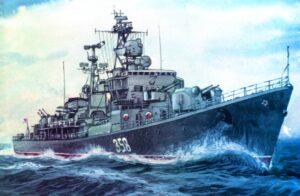 The Kotlin (project 56) are the first “true” post-war soviet navy destroyers, if we consider the Skoriy a continuation of the prewar Ognevoi design. The Kotlin derived from Neutrashimyy (or Tallinn, project 41-1951) with an improved flush-deck hull, born from a 1951 specification based on the Project 41. However if 100 were planned, only 27 were completed. The last five extra ships were completed to the new Project 56M missile conversion (Kidlin class) and the larger Krupny class being scheduled instead. The Kildin will be seen in a separate post. The 27 Kotlin received upgrades, some were converted as missile destroyers, others as ASW specialists, but they were soon seen as obsolete. Yet, they were only retired in the 1980s, being appreciated as very fast, seaworthy, long range and spacious, inspiring the following Krupny and Kashin of the sixties. #coldwar #sovietnavy #kotlin #kildin #destroyer
The Kotlin (project 56) are the first “true” post-war soviet navy destroyers, if we consider the Skoriy a continuation of the prewar Ognevoi design. The Kotlin derived from Neutrashimyy (or Tallinn, project 41-1951) with an improved flush-deck hull, born from a 1951 specification based on the Project 41. However if 100 were planned, only 27 were completed. The last five extra ships were completed to the new Project 56M missile conversion (Kidlin class) and the larger Krupny class being scheduled instead. The Kildin will be seen in a separate post. The 27 Kotlin received upgrades, some were converted as missile destroyers, others as ASW specialists, but they were soon seen as obsolete. Yet, they were only retired in the 1980s, being appreciated as very fast, seaworthy, long range and spacious, inspiring the following Krupny and Kashin of the sixties. #coldwar #sovietnavy #kotlin #kildin #destroyer
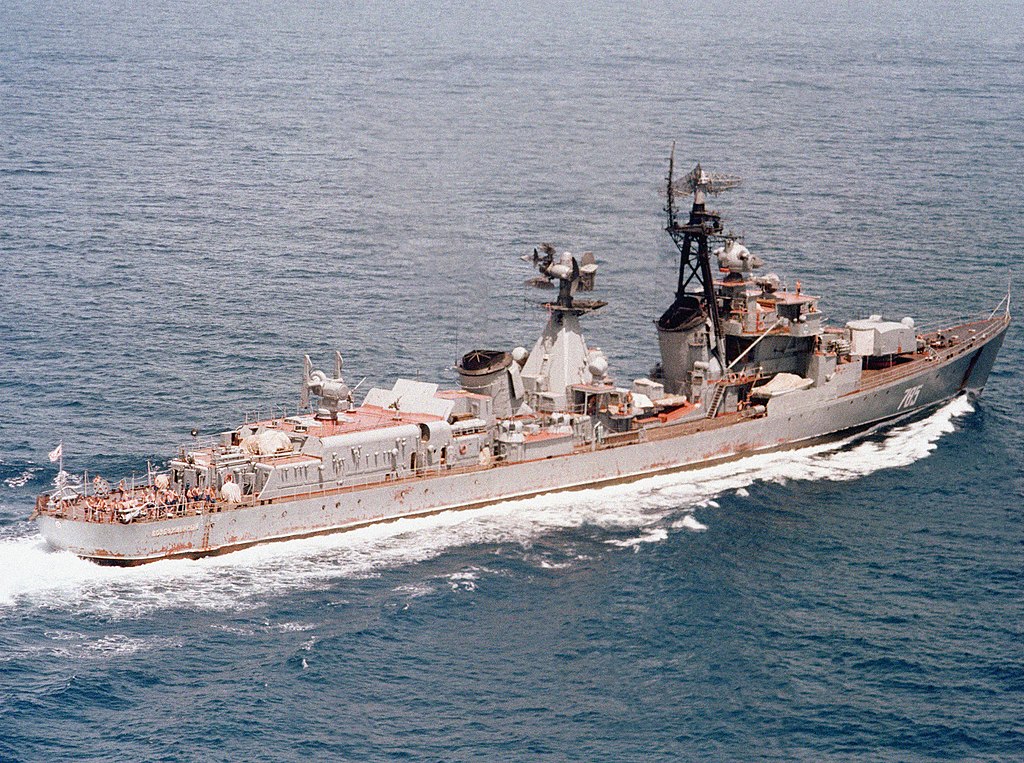
The Project 56 in brief
The Kotlin class (NATO denomination) or Project 56 were a derivative of the Skoriy, still armed with artillery and torpedo tubes, but with more extensive range and electronics. The development was long to reach the perfect balance from 1951.

Outline of the previous Project 41 from which Project 56 was derived.
Development of Project 56
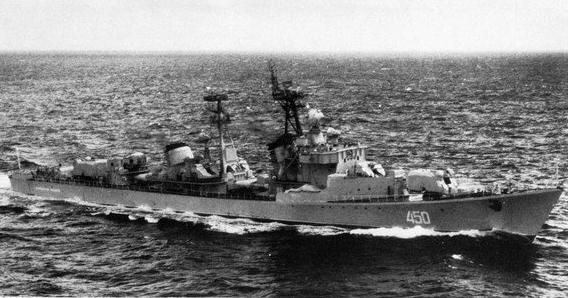
Soviet destroyer Vyderzhanny c.1973, in the Project 56 configuration
After WW2 appeared the Project 30bis destroyers, based on prewar designs, which answered to the need for more modern and larger units when compared to the Allen M. Sumner and Gearing class as well as the British Battle and Daring. After the Skoryi, the attention of the admiralty placed great hopes on Project 41 Neustrashimy, but it was too large and costly while not meeting expectations. The program was cust short after the only prototype. The sticking point was that it was seen as too large for a destroyer. A small and cheaper alternarive was preferrable at this point. In 1951 it was decided to rework the Project 41 design, similar architecture but smaller. One crucial point was to achieve greater speed on this reduced hull. On 02 June 1951, the Soviet government drafted the final specifications, and assigned it the denomination “large destroyer Project 56”.
The office CKB-53 was placed in charge of Project 56, under the direction of chief designer O. Fiszera in 1952. Their deadline was quite short.
The design of Project 56 in official documentation was stated at first as “modernized Project 41,” in the summer of 1951. After the June 2, 1951 (No. 1867-891) decree on “…changing the technical specifications of project 41.” Work under Fisher was assisted by deputy chief designer A. I. Toptygin, V. A. Toropov, V. G. Korolevich and engineer-captain 2nd rank M. A. Yanchevsky as Navy observer. By Resolution of the Council of Ministers No. 1867-891 a serie of changes were approved, and further detailed the ship’s missions:
-Conducting torpedo and artillery strikes on enemy warships and vessels;
-Providing combat and fleet protection from attacks by aircraft, submarines, destroyers and torpedo boats;
-Carrying out the tasks of sentinel and reconnaissance services in the ocean zone;
-Convoy security;
-Laying active minefields;
-Fire support for landing operations and coastal armies, shelling coastal targets behind enemy lines.
CKB-53 bureau modifications
What specified the new project compared to the Tallinn class were a reduction in full load displacement from 3,770t to 3,150t, full speed increased from 36kts to 39kts, cruising range at 14kts reduced from 5,500nm to 4,000nm, as well as stores endurance halved to 10 days, lighter torpedo tubes, unstabilized 45mm gun mounts, all to gain weight. Also quadruple SM-20s instead of twin SM-16s and even the amount of ammunition, down to 750 instead of 1000 rounds/barrel.
The first measure was to reduce the excessive displacement in order to improve the speed, from 36 to 39 knots, even if it meant sacrificing some autonomy by reducing fuel tanks. They were also new lighter torpedo tubes and new 45 mm AA guns. A grand total of 100 were initially planned in NATO literrature. But declassified information released in the 1990s only showed 32. The serie was was stopped with the 27th Proyekt 56 in October 1955. Indeed, the naval staff wanted missile destroyers as soon as possible, and the next project was the Kildin (1955, project 56M), based on the same hull. Kotlin plans were modified before launch: In particular, the hull was reduced in size, same propulsion plant from Neutrashimyy was used, the bow was raised, the hull partly made of aluminum and magnesium, and the machinery was pushed to reach 72,000 hp instead of 66,000.
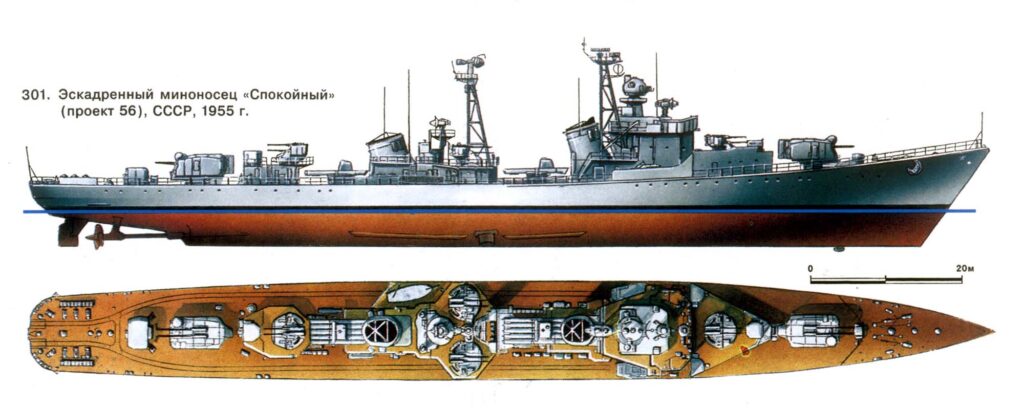
Final Design
To keep the delays, the usual preliminary design stage was skipped, the team working on the detailed design by February 1952 and a lot of prefabrication preceded keel laying to save more time. Preliminary figures deemed way too optimistic, were still confirmed by the TTZ of 4 April 1954 with a full load displacement beyond 3,220t, speed below 38.5kts, and 25mm guns eliminated. She much shortened the design completion and construction to launch was greatly accelerated.
For these destroyers, a new director, Sfera-56 was created, with a smaller Sfera-50 declined for the Project 50 frigates. The new 45mm guns were placed to form a rhombus for interlocking fire, but project 56 had no RBU rocket launchers. They will ne added later.
Hull & General Appearance

Extra large detailed plan of a Project 56 in initial configuration, as completed.
The Project 56 was certainly shorter than Project 41 Neustrashimyy.
Having essentially armament and powerplant from Project 41 for the smaller hull, it was necessary to replace many elements above the main deck and in that case, an aluminium-magnesium alloy was used for the superstructure, and to avoid stability issues, these destroyers were the first fitted with fin stabilizers.
If the general layout of weapons and technical equipment was preserved, the smaller main dimensions obliged designers of TsKB-53 to double the volume of superstructures (from 5.5% to 11.3% of the total volume of the hull), only making possible to install 45 mm AA guns. The heavier, bulkier 25 mm of Project 41 was scrapped. Later it turned out that impossible to meet the specified TTZ and further revisions had to be approved to give some much needed leeway and complete a realistic design.
The hull shape provided almost an internal battle: The solutions chosen by the designers of TsKB-53 did not suited at all representatives of the Navy at first. Admiral of the Fleet I.S. Isakov proposed to retake a Novik-class hull as basis, citing his experiences with these. But if they latter were acceptable for closed seas such as the Baltic or Black sea, they were of little use for the Barents Sea or Pacific Ocean. The dispute escalated into open conflict between the Navy Ministry and the one of Shipbuilding Industry, with discussion under the authority G.M. Malenkov, which cut into the matter by declaring “whoever sails, should choose the contours.” Vyacheslav Malyshev (Minister of Transport and Heavy Engineering) appealed to I.V. Stalin directly which eventually accepted the point of view of the designers.
Other than that, the general outlook was very much the same as the original Project 41, with a “three islands” configuration: The bridge, foremainmast and forefunnel, first TT bank, aft funnel and mainmast, second TT bank, then quarterdeck house, rear FCS and rear armament.
The flush-deck hull and developed superstructures, significant flare of the bow, carefully developed in the pool of the Central Research Institute “A. N. Krylov” testing various bow shapes and using a pitch stabilizer with two onboard steerable rudders retracting into the hull. The latter were certainly the major innovation of the design, stability wise, and certainly much advanced for the time.
Powerplant
Main two stage turbines
The main power plant repeated the one of Project 41 in general outline, itself combining high and low steam pressure in a single thermal circuit. At high steam parameters, the power plant operated only at high speeds, then at intermediate and low speeds, low steam, which theoretically increased its efficiency. Structurally it consisted of two high-speed double-flow main turbo-gear units (GTZA), TV-8 type, for a total design power of 33,000 hp. The two turbines were divisied between an active type turbine, high pressure, and a two-flow reactive low pressure one, as well as a condenser and a gear transmission with main thrust bearing, shaft clutch and braking systems.
Between the forward ducts of the low pressure, there was a two-flow reverse turbine. The 2-gear gear transmission enalbed split power and the circulation system for the main condenser provided a technical and economical 14 knots cruise speed and 2nd cruising 29 knots high speed mode. To ensure the specified speed the TV-8 turbine system was boosted, by increasing turbine nozzles output and steam output of the main boilers, higher temparature and pressure, for a total capacity of 36,000 liters.
Steam Boilers
Steam was generated by four main steam boilers of the KV-41 type working at 450 °C and 64 kg/cm². They were of the vertical water-tube type with natural circulation. This was assorted with vertical double-collector superheater, water fin economizer. One boiler alone produced 80 tons of steam per hour. The temperature can reach up to 470° at 25-64 kgf/cm. The small size of these KV-41 boilers, just 6 m long, made it possible to place them in single compact compartment with while maintaining acceptable operating conditions. The boilers were installed facing each other in each of the two separate compartments.
There was a single control room for each of these, monitoring all boilers parameters. To carry out forced blast directly into the furnace new automated pumping air turbine TVK-9 were installed to control the air feed, condensation and booster pumps, single drive installed in the casings. Water lubrication was used for bearings. Yet the efficiency of the boilers was lower than on the prototype (Project 41), just 74% compared to 78-79%. Steam for auxiliary needs were provided by a KVS-41 auxiliary boiler (5 tons per hour, 28 kg/cm²). In turn it powered a generator for electricty aboard, and acted as backup as well.
To increase survivability, two intermediate compartments and one separated for “deep” fuel tanks. The aft intermediate compartment contained magazines for 45 mm rounds, the bow contained the auxiliary steam boilers and generator.
Start and Consumption
The power plant was adapted for launch without pre-heating for emergency departure. From a cold state to full pressure was achieved in just 15 minutes. According to calculations, this dual-mode powerplant ensured lower fuel consumption in economic speeds (something Gibbs & Cox of NY already found on in the 1930s working on US liners and destroyers).
During trials of Spokoiny, it turned out that the powerplant in full and operational-economic speed modes was not economical. The acceptance trials report noted:
“…even short-term submarine attack, evasion of aircraft sharply reduces the tactical cruising range. So, for example, one hour of full speed reduced the operational cruising range of a 30bis by 104 (nautical) miles, but on project 56 by 184 miles.”
Excessive consumption and fragility of boilers sub-elements, a number of other design flaws were noted. But these were all adressed before the lead ship was transferred to the fleet, and on serial ships modifications were amde during construction. The report noted however that this output exceeded the specified power by 1,000 hp. s., at 73,000 hp, which was no small feat.
As for the internal electricity production, the power also produced a total of 1200 kW, whiuch included the two 400 kW TD-12 type turbogenerators and two DG-200/1 diesel generators for three-phase alternating current (220 volts, frequency 50 hertz). They were located in two sections at the bow (upper intermediate deck, bow) and aft (under the intermediate deck, stern). This repeated the electrical power scheme of Project 41 but the latter had in addition a 100 kW turbogenerator TD 8/1 absent on the Kotlins as there was not room for it.
Steering
On the lead ship steering consisted of two semi-suspended rudders to improve controllability, and propellers with a diameter of 3.8 m on shaft brackets instead of fairings based on the experience of testing pre-war “Leningrad” and “Minsk” flotilla leaders. It made it possible to reduce the heterogeneity of the velocity field in the propeller disk, reduce its erosion. As a result of full-scale tests of Project 41, the Central Research Institute A.N. Krylov recommended replacing the propeller shaft brackets with fairings, to eliminate any speed loss, and replacing the semi-suspended rudders with suspended balance rudders. By July 1954 work was done to change the steering layout for the ship’s preior to completion while those too advanced were left in their original configuration.
First high-speed tests of Spokoiny in September 1954, showed that with the original layout did not ensured to meet the specified speed at 34.7-34.8 knots instead of the required 38,5 kts. Studies conducted on propeller shaft bracket cavitation and propeller performance revealed bracket cavitation had adverse effects of on the propeller’s performance. Based on this research one semi-balancing rudder of double area was installed, while the propeller was enlarged op to 4 m while its disk ratio and propeller blades went to four. The introductionof this new design brought an increase in speed by 1.9-2.0 knots and the next destroyers all achieved the specification speed.
Armament
Main:
The two twin turrets housed the stabilized universal guns SM-2-1, 58 caliber. They were on deck level fore and aft. Each used the new Sfera-56 instead of the Shtag-B radar rangefinder. Thet were operatable from local or fully remote control. Both barrels were on a common cradle and used a new stabilization system, but the latter was not reliable and its development was discontinued. The Yakor-M radar provided data, stabilized by the SPN-500 rear system.
Anti-aircraft artillery:
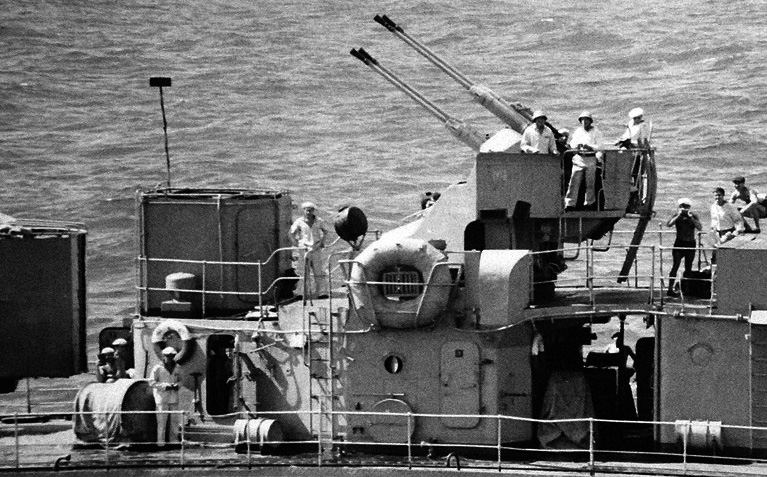
The ship had four stabilized twin 45 mm SM-16 mounts in a lozenge pattern. The SM-16 were controlled either from the main local fire control system as well as independent MZA telemeters, assisted by the Foot-B radar. The 4M-120 guns were operated manually. They were provided with 4,000 and 10,000 rounds respectively total.
Torpedo armament:
It was represented by two quintuple 533-mm torpedo tubes, relatively classic and standardized. It was the same type as found on light cruisers of the project 68-bis (Sverdlov class). The torpedoes fired were likely of the PTA-53-41 Stalingrad T-41 coupled with the Zarya fire control system. This type which was later replaced by the model 53-51 (entering service in 1951), still a non-homing model but weighting, 4,134 lbs. (1,875 kg) for 299 in (7.6 m) in lenght, carrying a 661 lbs. (300 kg) warhead up to 4,400 yards at 51 knots or 8,750 yards (8,000 m) at 39 knots, using a Kerosene-air wet heater.
Mines:
In addition of mine rails mounted on the upper deck to carry up to 48 KB Krab naval mines or 48 GMZ models could be carried in all, conveyed to the mud chutes at the stern. In addition, Neustrashimy carried six BMB-2 DC projectors (48 in store) on the broadside, and two depht charge throwers, automated reload, with 57 in reserve. There was a General-purpose long range radio equipment and of course the the Foot-N air target detection radar, and Rif surface targeting system, plus the Pegasus Sonar.
Sensors
Noted issues were cramped combat posts and electromagnetic incompatibility bewteen systems.
The fire control system for anti-aircraft guns comprised the Fut-N airborne surveillance radar located on the main mast and two Fut-B radars installed on the wheelhouse and behind the main mast. Due to the unavailability of the Fut-N radar, the first ships were equipped with the Reef general detection radar.
Target designation for ASW used the Pegasus-2 hydroacoustic station (sonar) which maximum detection range in echo direction finding mode under the most favorable hydrological conditions was just 2.8 km, but in reality it was even less, and also unable to detect the diving depth of an enemy submarine.
For navigation, the latest models were used, Kurs-4 gyrocompass, KP-M1 and KP-M3 magnetic compasses, Put-1 autoplotter, NEL-4SU echo sounder, ARP radio direction finder. The modernization and conversion into ASW variant (Project 56PLO) saw the replacement to the new LG-50 lag system, and Machta-P4 electronic intelligence station, and Pegasus-2M GAS sonar which had improved range.

Vyderzhannyy underway circa 1973
Construction
The keel for the construction of the first was laid down in February 1953, launched by October 1953, so quite fast. The same year saw the start of 10 ships, given the objective or replacing remaining WW2 destroyers, with 100 on order. The first to be completed, “Spokoyny” became in USSR the official class name. Completion took quite long however, and between 1954 and 1956 she underwent many tests, trials and testing at sea, only entering service on 27 June 1956.
By 1956 thirteen entered service and by 1957 the last 11 of the project. By 1958 four revised Project 56EM/M were started. The original 100 are not confirmed in the official documentation which specified 32 on order, including the four completed as the Kildin class and the very last vessel canceled. 31 Project 56 destroyers were built in total as planned at 190 im. A.Zhdanov NyD in Leningrad, No. 199 im. Lenin Komsomol NyD in Komsomolsk-on-Amur and No. 445 61 Communards nyD in Nikolayev.
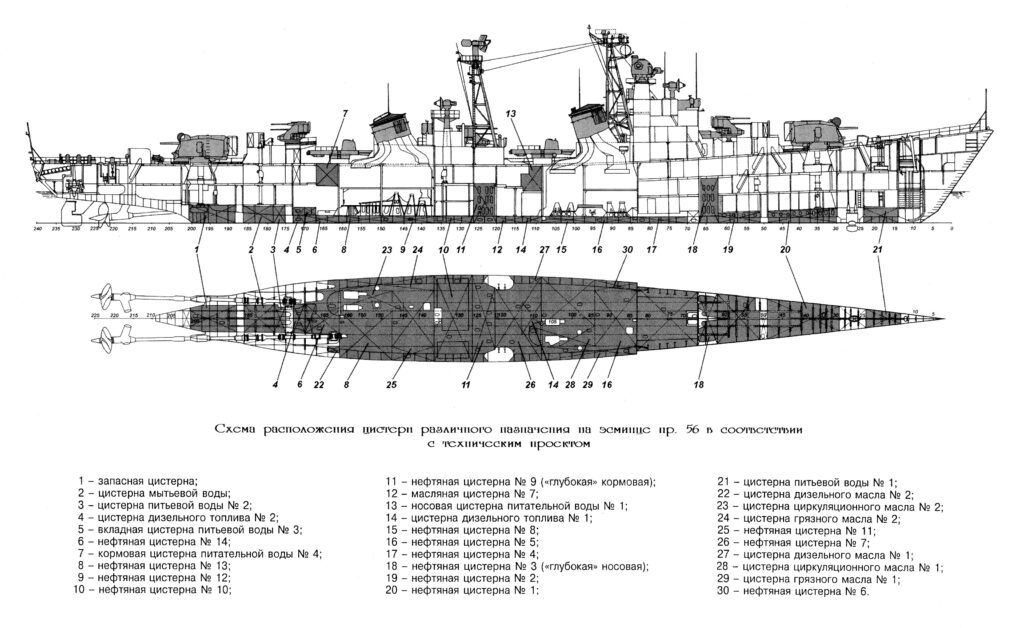
Cutaway and compartimentation of the Project 56
General Assessment
A historical landmark for the Soviet Navy
The Project 56 were the last conventional destroyers built in USSR, a good answer to the US Forrest Sherman class, their contemporaries. Their appearance was modern, yet they entered service while already being obsolete as the USN were launching and completing their first missiles destroyers, the Charles Adams. The naval staff expressed concerned they their artillery and anti-submarine armament was inferior to US destroyers of the time. The last SAM Kotlin and MOD Kildin were retired still in the late 1980s, a remarkable longevity due to several advantage. And they were costly: Unlike the previous Skoryi. Only a single Kotlin was ever exported: The Kotlin SAM “Spavedlivy” transfered to Poland, renamed ORP Warszawa (“Warsaw”). The “Kotlin” programm did not ended with the Project 56A, nor 56M (Kildin) but with the additional eight Krupnyy and their Kanin missile variant, larger but of a similar design. With them all the critics of the Kotlin were adressed. But the real first missile destroyers in USSR became the Kashin, a brand new design, yet reusing the same flush deck hull.
Combat damage/Survivability assessment
Structural protection was provided by local anti-fragmentation armor. The conning tower as well as bridge fencing, walls of local control posts for torpedo tubes and boiler casings, and ready ammunition storage bins were protected by homogeneous rolled armour with anti-fragmentation layer 8-10 mm thick. Gun turrets and aiming posts were protected by reinforced armor of up to 20-40 mm. Underwater protection was ensured with floatiability and enough buoyancy even when three adjacent compartments or both engine and boiler rooms were flooded. Also the power electrical network was well separated between the bow and stern, and used armoured cables encased in a rubber sheath with a metal shell, passing through special corridors routes. The entire power plant had increased survivability.
The level of combat survivability was demonstrated when attempting to sink “Vozbuzhdenny” as target ship in 1990 off the coast of Kamchatka. Anti-ship missiles were fired from three Nanuchka class small missile corvettes (Project 1234) and a coastal missile battery from Cape Shipunsky. Even with two gaping holes in the superstructure and several fires, she remained afloat. She had to be towed to Petropavlovsk-Kamchatsky for reuse as target, this time to train naval artillery. She was targeted by the patrol ships Retivy and Rezky. Both patrol fired some 110 shells at her, certainly causing widespread damage on her superstructures and hull, but again she remained afloat. She was only sank when Rezkiy came at point blan range to pepper her waterline with her 100-mm AK-100 guns until flooding was unstoppable.
Variants
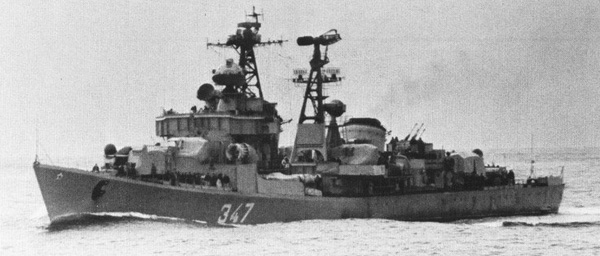
Destroyer Spokoynyy in Project 56PLO configuration (Kotlin Mod, the ASW variant) in 1973
Project 56K: Bravy was completed as a “Kotlin SAM”, experimental prototype to test the SA-N-1 before 7 ships were modernized.
Project 56A (NATO Kotlin SAM): Production conversion with a SA-N-1 mount aft in place of the original gun, first Soviet SAM destroyers.
Project 56PLO (Kotlin Mod): 12 units modernized as dedicated ASW vessels.
Project 56M: NATO Kildin, a much improved version of the 56A, with antiship capabilities in addition to SAMs. First true soviet missile destroyers.
Naming
The project 56 destroyers were identified in USSR also as the type Spokoynoye “Peaceful”, first completed, before being assigned by NATO the designation Kotlin according to the letter “K” given to the nomenclature of ATO for Soviet destroyers. They were referring also to the location of the Baltic Kronshtadt Naval Shipyard, Kotlin Island at the mouth of Neva Bay, St Petersburg.
Post-Trials modifications
From the start, they were fitted with rudder stabilizers, the propellers evolving from three to a four blades design to alleviate vribrations making the sonar unusable. All these modifications contributed, in the opinion of all Russian sailors, to make excellent destroyers, which also explains their longevity in service (1987-1990 for the most part). They were stable, “dry” because of their high bow, light, very fast (up to 42.9 knots in lightened tests), and their machinery was robust enough that the kept very high speeds until the end of this service. In 1958, 12 units were modified as ASW conversions as seen above, in addition to the SAM variant.
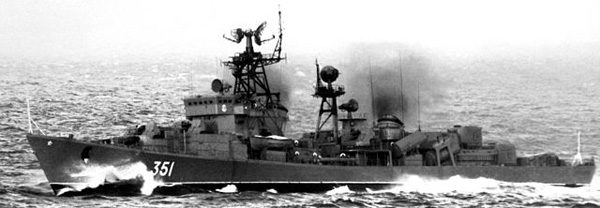
Destroyer Prozorlivyy, 1942
Modernizations
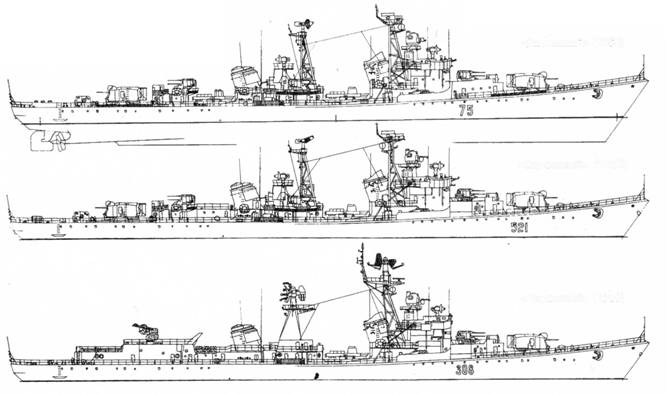
Skromnyy (Скромный, “Humble”) in 195, 1962 and 1969, showing the modifications to the basic design. The open bridge was enclosed notably, some equipments were upgraded, notably the mediocre sonar.
Project 56A (Kotlin SAM)
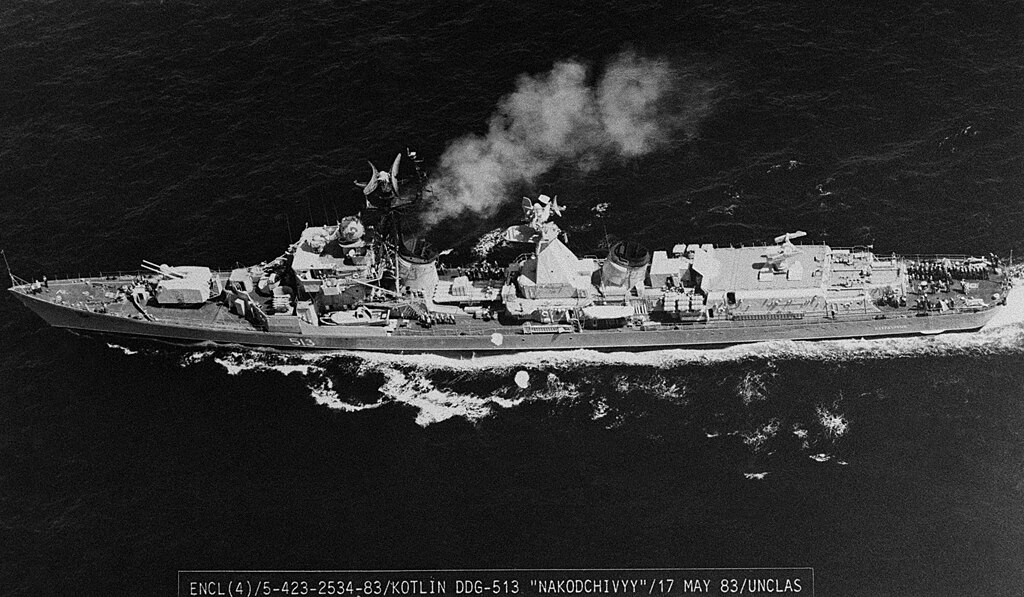
In 1959, Bravyy was modified to receive a SA-N-1 missile launcher, which it tested until 1963, followed by eight ships with similar upgrades in 1969-71. In the end, there remained 7 unchanged ships, only three equipped with helicopter platforms. The Kotlin and their modified sub-vaiants were withdrawn from service just before 1990 (1985-89) for 21 of them, while still four were extant in 1990, retired from service two years later.
So in substance, these had a single twin 130 mm (5.1 in) SM-2-1 gun left forward,
A single quad 45 mm (1.8 in) SM-20-ZIF gun also forward,
Four twin 30 mm (1.2 in) AK-230 guns,
Single quintuple 533 mm (21 inches) TA MPTA-53M torpedo tubes,
Two twelve-tubes 213 mm (10 in) RBU-6000 ASW rocket launchers
A twin S-125 Neva/Pechora (NATO SA-N-1) SAM (16 missiles) aft,
And rails, chutes, to carry and drop 50 mines
Project 56 PLO (Kotlin mod)
12 units taken in hands modernized as dedicated ASW vessels. The modification consisted in the removal of their aft TT bank, and mount two RBU 2500 and two type RBU 600 ASW rocket launchers while the remaining TT bank was modified to launch acoustic homing ASW torpedoes.
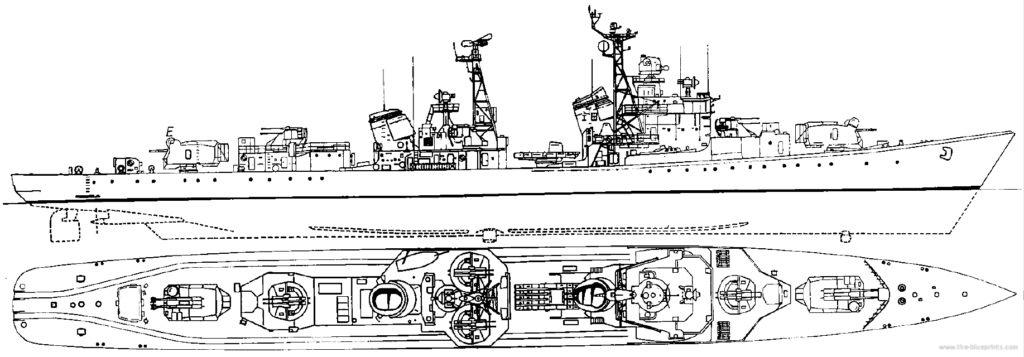
Naporystyy in 1966, semi-modernized Kotlin design. The aft TT were removed with an installation in its place, but no RBU ASWRLs not CIWS are visible.
Project 56M (Kildin)
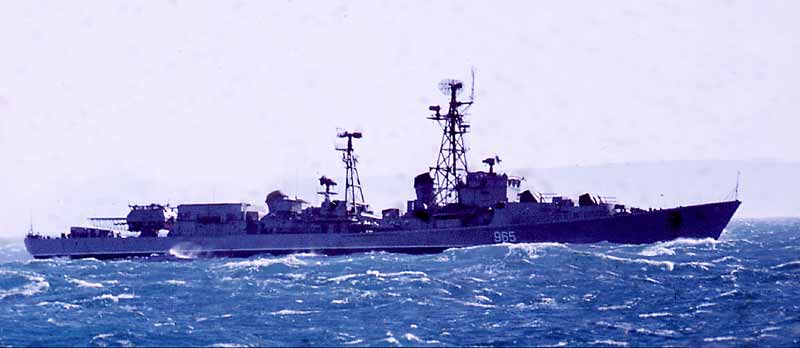
Neuvolivy off morocco, January 1970, pre-modernziation
In resume, as they will be seen in detail on a future article, the Kildin were a dedicated missile variant, too different to be considered as a meter “Kotlin”, albeit Conways and many other sources placed them in the same class. Indeed, official documentation specifies the “project 56M”, placing them as parrt of the Project 56. It’s NATO that decided to assign them a new denomination.
The Kildin-class were a fully missile armed conversion, named by NATO for Kildin Island. Four only were built, carrying the KSShch (КСЩ, SS-N-1) anti-ship missile. When obsolete in the 1960s, three were modernised in 1972-1977, and eventually decommissioned in the late 1980s and early 1990s, so they stayed in service for the duration of the cold war. Soviet designation Project 56EM was only for the prototype (Bedovy), Project 56M for three serial ships, Project 56U for their modernisation, post 1977.
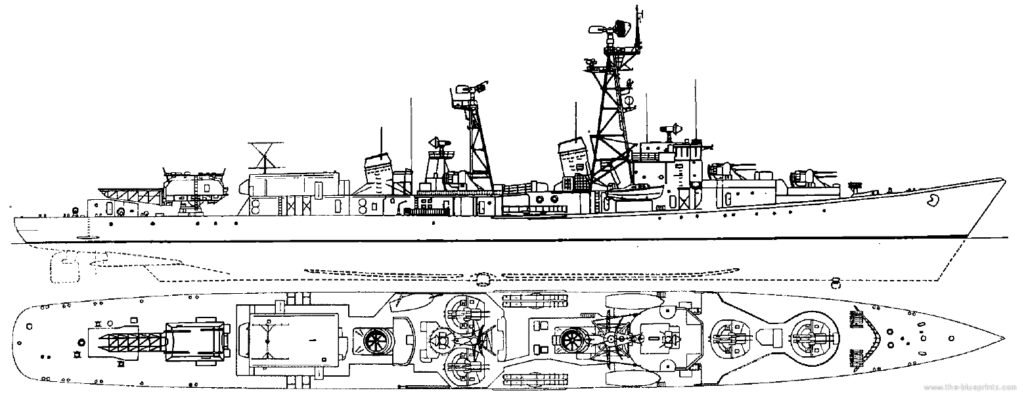
Project 56E Neuderzhimy (Initial Kildin class)
Bedovyy was fitted out as test platform for the new KSS anti-ship missile, receiving the Kiparis system with a tailored gunfire direction system for missile control, in addition to their Sfera director. It was made operational just as the the Project 57 class were developed for the KSS missile. Three more ships were completed in what became the Kildin or 56M. They had the new quadruple 57mm secondary gun, paired beam torpedo, and armoured hangar aft containing six missiles.
They received a large aft SSM launcher quad bank, fitted at the stern. The forward 130mm gun was removed and replaced by two quad 57mm AA guns (45mm in Bedovy). The torpedo tubes were replaced by twin semi-fixed 533mm tubes in the beam to spare space. When obsolete, the rear missile ramp was removed and two 76mm gun turrets installed in a superfiring position aft (like the Krivak class Frigates), plus four SS-N-2 missile launchers on either side on the bridge.
These ships were the:
Bedovy (“Mischievous”) from Zhdanov Shipyard, scrapped 1989
Neulovimy (“Elusive”) from Zhdanov, scrapped 1990
Prozorlivy (“Perceptive”) from Nikolayev, scrapped 1991
Neuderzhimy (“Unrestrainable”) from Komsomolsk na Amure, scrapped 1985, never modernised
Neukrotimy (“Indomitable”) cancelled, never laid down.

Kildin class, Neuvolimyy off Morocco January 1970

USS Kildin in March 1975

Modernized Kildin Neulovimyy after modernization 1970s

Project 56 Plamenny as completed in 1957

Project 56A Bravyy as converted

Project 56M Prozolivyy

Project 56M Bedovyy

Author’s illustration – Kotlin class
⚙ Project 56A specifications |
|
| Displacement | 2,662 tonnes (standard), 3,230 t full load |
| Dimensions | 126.1 x 12.7 x 4.2 m (414 x 42 x 14 ft) |
| Propulsion | 2× shaft geared steam turbines 4 boilers, 72,000 hp (54 MW) |
| Speed | 38 knots (70 km/h; 44 mph) |
| Range | 3,090 nm at 17.9 kts (56K 3,000/18 kts) |
| Armament | 2×2 130 mm SM-2-1, 4×4 45 mm SM-20-ZIF, 2×5 533 mm PTA-53-56 TTs, 6× BMB-2 DCT, 50 mines |
| Sensors | Radars Fut -N (air search), Ryf (surface), Sonar Pegas |
| Crew | 284 |
Read More/Src
Books
Apalkov Yu. V. Destroyers of project 56. St. Petersburg: Galeya Print, 2006.
Apalkov Yu. V. Destroyers of projects 56, 57 bis and their modifications. – St. Petersburg: Morkniga, 2009.
Vasiliev A.M. et al. SPKB. 60 years with the fleet. – St. Petersburg: History of the ship, 2006.
Zabolotsky V.P., Kostrichenko V.V. Hounds of the oceans. History of Project 61 ships. – M.: Military Book, 2005.
Kuzin V.P., Nikolsky V.I. USSR Navy 1945-1991. – St. Petersburg: Historical Maritime Society, 1996.
Pavlov A. S. Destroyers of project 56. – Yakutsk, 1999.
Platonov A.V. Soviet destroyers. – St. Petersburg: Galeya-Print, 2003. T2.
Kuzin V.P. Destroyers of Project 56 // Shipbuilding: magazine 1994. No.1
Rusetsky A. A. The creation of the Project 56 destroyer is an important stage in the development of ship hydrodynamics // Shipbuilding: magazine.
Zvinyatsky A., Timokhin I., Shalomov V. Far Eastern destroyers of project 56 (to the 85th anniversary of Komsomolsk-on-Amur). // Marine collection USSR Navy.
Sokolov A. N. Fleet consumables. Destroyers of the USSR and Russia. – M.: Military Book, 2007.
Kuzin V. Destroyers of projects 41 and 56. // “Sea collection”. – 1992. – No. 11. – P. 51-56.
Conway’s All the World’s Fighting Ships, 1947—1995. — NIP
Links
https://en.wikipedia.org/wiki/Kotlin-class_destroyer
https://ru.wikipedia.org/wiki/%D0%AD%D1%81%D0%BA%D0%B0%D0%B4%D1%80%D0%B5%D0%BD%D0%BD%D1%8B%D0%B5_%D0%BC%D0%B8%D0%BD%D0%BE%D0%BD%D0%BE%D1%81%D1%86%D1%8B_%D0%BF%D1%80%D0%BE%D0%B5%D0%BA%D1%82%D0%B0_56
https://www.globalsecurity.org/military/world/russia/56.htm
https://commons.wikimedia.org/wiki/Category:Spokoynyy_class_destroyer
http://forums.airbase.ru/2009/04/t60019–eskadrennye-minonostsy-proekta-56-i-ikh-modifikatsii.html
https://ru.wikipedia.org/wiki/%D0%91%D1%8B%D0%B2%D0%B0%D0%BB%D1%8B%D0%B9_%28%D1%8D%D1%81%D0%BC%D0%B8%D0%BD%D0%B5%D1%86%29
https://coollib.com/b/165819-aleksandr-sergeevich-pavlov-pro-flot-eskadrennyie-minonostsyi-proekta-56/read
http://russianships.info/eng/warships/project_56.htm
https://flot.com/publications/books/shelf/reddragon/26/index.php?print=Y
http://commi.narod.ru/bmc/mk1dd/dd60.htm
https://dzen.ru/a/X87xzwpFqRz0zair?utm_referer=www.google.com
http://www.and-kin2008.narod.ru/pr56.html
https://vmf.net.ru/forums/viewtopic.php?t=12
http://www.navypedia.org/ships/russia/ru_dd_spokoynyy.htm
career of the ships on znaki-flot.ru/
war-book.ru/ tons of photos, plans and profiles
on war-russia.info/
Videos
Model Kits
various 3d views on scalemodels.ru/
3D
 Spokoynyy
Spokoynyy
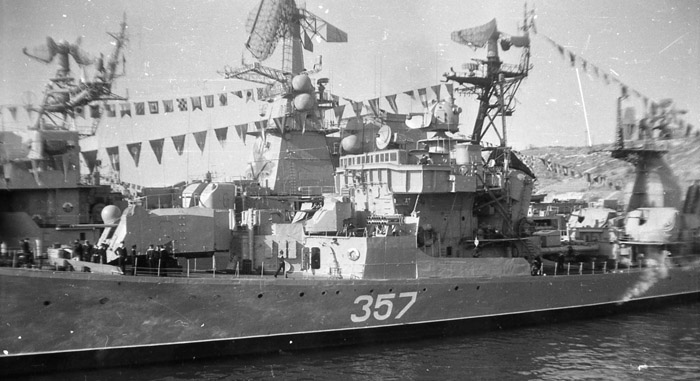
Built in Leningrad, Zhdanova she was laid down on August 19, 1952, but again on March 4, 1953 for the official laying, already with 33% hull complete (design revisions) and launched on November 28, 1953, with sea trials starting on April 26, 1954, artillery tests on August-September and final acceptance in December 1955. She was completed officially on June 27, 1956 and entered service on October 9, 1957, assigned to the Baltic, and from September 1956 to the Northern Fleet, DesRon 121. On September 26 she took part in the rescue of the submarine M-256. In March-April 1957 she performed exercises watched by the USSR Ministry of Defense.
By April 1958 she took part in the Northern Fleet exercises and again in 1959. From July 5, 1959 she was transferred to DesRon 170. By November 1961 she was transferred to the Baltic Fleet for modernization at LenVMB, massive overhaul until 1964. From May 1966, she was reclassed as artillery/torpedo ship, 2nd rank. In 1966 she took part in artillery tests. She took part in “Sever-68” exercises. In April 1970, “Okean” exercise. From July 5, 1971 to May 7, 1973 she was on overhaul at Kronstadt. In 1973, she sailed to the Shetland Islands for exercizes. From October 1, 1978 she was back with the Northern Fleet, DesRon 56, DesDiv 7. In 1979, she took part in Northern Fleet exercises. From April 1, 1980 to August 3, 1983 she was overhauled at the 35th shipyard in Murmansk and reassigned to DesRon 206. Mothballed on March 25, 1984, she was decommissioned on April 19, 1990, stricken October 1, 1990, sold for BU in 1991, in Rost.
 Svetly
Svetly
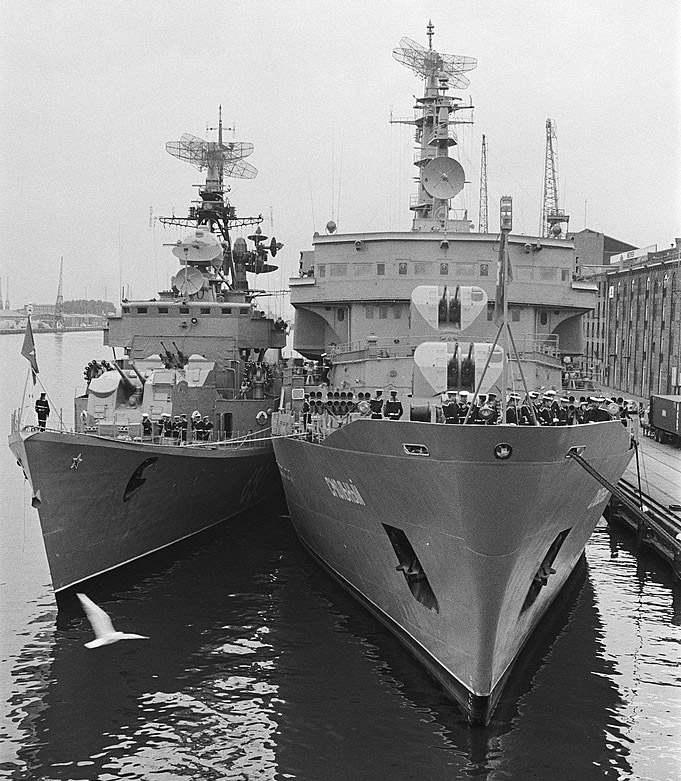
SVETLY was from the Leningrad plant, Zhdanov, completed in June 1955 and commissioned by September 26, assigned to the 4th North-Baltic division. Since 1957 she had a helipad in the stern for testing the the Ka-15 helicopter in 1958-59. In 1957 she took part in qualification artillery exercises and 1958 ASW exercises then in 1960 to tactical exercises. By October 18-22, 1962 she visited Rostock in East Grmany accompanied by a sister ship. By May 8-12, 1964 she went to the west and visited Copenhagen in Denmark under Admiral A.E. Orla aoard flagship cruiser “Komsomolets” and “Spravedliy”. She was overhauled in 1965. In 1966 she took part in the Baikal exercise. On July 3-7, 1967 she visit with Kirov Stockholm in Sweden under Rear Admiral Belyakova. By September-December 1967 she was transferred to the Mediterranean escorting two missile cruisers.
In the spring of 1968, she was repaired in Liepaja. In 1968, cap. 2nd rank Yu.P. Zhurkin took command and by 1969 she took part in Baltic Fleet exercises. From February 18, 1970 to July 5, 1971, she had another overhaul at Liepaja. The summer of 1972 saw her engaged in large exercizes in the North Atlantic with Obraztsovy. In September 1973 to April 1974 she made another Mediterranean cruise with sisters Speshny and Obraztsov. On June 21-26, 1976 she visited Bordeaux (France) on her way back to the North Sea. In heavy swells she had a torpedo fell from the bow tube and sink. She had another overhaul in 1977 at Liepaja and by June 1978 she was hit by another manoeuvering ship while moored, was flooed and sank at the pier. In 1979 she was repaired, and by August 22, 1980, she layed mothballed in Tallinn until decomm. on April 25, 1989, stricken October 1, 1989, BU in 1990 at Liepaja.
 Speshny
Speshny
SPESHNY was built at Leningrad, Zhdanov, completed on September 30, 1955, commissioned on December 19, 1955. She was part of the 4th division, North Baltic. In 1957 she qualified in ASW training, 1958 artillery, and same on the 1959 exercises. In 1960 she was in tactical fleet training. In 1961 in artillery drills. In 1963 tactical exercises. In 1965 ASW exercises and from November 18, 1966 to January 6, 1969, overhauled in Kronstadt. On September 12, 1969, when firing one of her shell hit nearvy Neustrashimy. By April 10-27, 1970 she took part in her first major Ocean maneuvers in the Atlantic. By July 17-23 she was present off Syria and went on with her service in the Mediterranean Sea until back home in August 1970. From January 11, 1971 and until July 1971 she was back in the Mediterranean with the Kirov class Oktyabrskaya Revolutsiya, sister Nastochivy and Obraztsov. By June-November 1972 she returned with Oktyabrskaya Revolutsiya and three destroyers. From December 8, 1972 to April 9, 1973, she was overhauled at Liepaja SRZ-29. In September 1973 until April 1974 she was back in the Mediterranean Sea with Svetly and Obraztsovy. Next sher trained in the Western Atlantic from October 30, 1978 to February 8, 1979 and operated off Angola, Gulf of Guinea. In 1980, cap. 2nd rank A.V. Gavrilov took command and from March 15, 1984 to March 13, 1985, she was overhauled in Tallinn. From 1985 cap. 3rd rank I.N. Kinyakin took command. From April 25, 1989 she was decommissioned, stricken by December 31, 1989, sold for BU 1990-91.
 Skromny
Skromny
Skrommy, (“MODERATE”) was built in Zhdanov, Leningrad, commissioned on January 11, 1956. She made her shakedown training in the Baltic. On September 12, 1956 she sailed to Severomorsk, assigned to the Northern Fleet, DesRon 121. In 1956-1957 she had sea trials at the Northern Fleet. From November 12, 1958 to November 29, 1960, she as converted as ASW variant, Project 56 PLO in Zhdanov and joined afterwards DesRon 170. On June 24, 1965 she left Severomorsk for the Baltic Fleet. From July 7, 1965 to November 19, 1969, she was modernized in Kronstadt as a Project 56A missile ship, joining the 7th division of the Northern Fleet, DesRon 170. By April 10-27 1970 she took part in “Okean” fleet exercizes and rescue operation on the damaged submarine K-8. In 1972, she was in the Western Atlantic, visiting Bissau in Guinea and by March-May 1972 she visited Havana, Cuba, repaired at Rosta. In May 1973 she visited Pointe Noire in Congo-Brazzaville and by June 12 to October 10, she assumed a military presence off Guinea. By August 15 1977 she was overhauled and by October 1978, joined DesRon 56, DesDiv 7. On March 14, 1980, she was transferred to conservation at 176 BRKrez 2 DPL (Sayda Bay) but decommissioned on April 25, 1989, stricken October 1, 1989, BU in Italy by 1990 at Porto Nogaro.
 Svedushchy
Svedushchy
She was built at Zhdanov, Leningrad, completed on January 31, 1956, commissioned on February 16, 1956. After shakedown overhaul in the Baltic, in October 12, 1956 she was assigned to the Northern Fleet, DesRon 121 and from November 12, 1958 she had an overhaul in Leningrad, Northern Shipyard. On July 5, 1959, she was transferred to DesRon 170. On October 29, 1960, she was again in overhaul and mothballed. By July 17, 1962 she hosted the USSR Ministry of Defense by R. Malinovsky and Commander in chief of the Soviet Navy S. Gorshkov for exercizes. Since October 5, 1963, the Black Sea Fleet included 11 Kotlin destroyers, largest concentration of the class. In 1964 she took part in ASW training as well as in 1965, 1966 (artillery firing) and had a major overhaul in 1967. In 1968, she took part in the large fleet ASW exercizes “Zarya”. Same in 1969 and 1970. In 1971-73 she was in restructed availability, and by 1973 was assigned to the Mediterranean Sea, escorting cargo ships from the Dardanelles to Latakia in Syria. In 1974, she returned to the Mediterranea and by August 1977 to June 1979 she stayed at Sevastopol Marine Plant for conversion as Project 56-PLO (ASW) mothballed in Sevastopol (Troitskaya Balka) in 1980, reassigned as landing fire support ship. On April 10, 1981, while mooring in Sevastopol she was badly damaged (by fire?) and repaired. On April 8, 1992 she was decommissioned, stricken on December 3, 1992 and BU in November 1993.
 Smyshleny
Smyshleny
“SMART” was also from Leningrad plant, completed June 28, 1956, and commissioned on August 30, 1956, after shakedown training, assigned to DesRon 121st, Northern Fleet, HP Severomorsk. In March-April 1957 she took part in exercises under inspection by the USSR MoD, declared “excellent in all areas”. On October 29, 1958 she was exceptionally renamed “MOSKOVSKY KOMSOMOLETS”. From November 12, 1958 to December 1, 1961 she was modernized at Zhdanov as a Project 56-PLO (ASW) and assigned to DesRon 170. From July 1 to July 25 and August 30 to September 28, 1964 she was in exercizes in the Norwegian Sea as in 1965 with, and North Atlantic for the “Pechora” exercise. From November 21, 1965 she was overhauled at Sevastopol. From January 4, 1968 she was reassigned to the Northern Fleet, DesRon 170 armored, 7th Div. for exercises “North-68”. By October 25-28, 1969 she visited Reykjavik under flag Rear Adm. I.V. Solovyova. In April 9-27, 1970 she took part in “Okean” and by August 9-14, 1971 visited Algeria. In September 31, 1971 to January 20, 1972 she was based on Cienfuegos, Cuba. From December 2, 1972 to June 2, 1975 she was overhauled on Kronstadt. In January 2, 1976 – July 12, 1976 she closely monitored NATO exercises in severe storm. Until May 17, 1977 was she modernized at Rosta wit an experimental non-acoustic search equipment in the stern. By October 10-15 1977 she visited Oslo under flag Adm. V. Kruglyakov. By May 10-14, 1978 she stopped in Bordeaux. By October 1, 1978, she was reassigned to DesRon 56 and by December 1978 to March 1979 was part of a major deployment in the Mediterranean in a task force centered around the Kyiv. By April 5-12 1979 she took part in exercises “Razbeg-79” with Kyiv, Marshal Timoshenko, Admiral Makarov, and the new destroyer Ognevoy. In 1982 she took part in artillery drills. From April 20, 1983 she was overhauled in Kronstadt and joined DesRon 206. By July 22, 1986 she was decommissioned, stricken February 27, 1987 and left to rot at Rosta, semi-disassembled for spares.
 Skrytny
Skrytny
“Stealthy” was built in Leningrad, Zhdanov, completed October 29, 1956 and commissioned November 2, 1956. She was assigned to the Baltic Fleet from November 5, 1956, DesRon 128. Overhaul by February 12, 1960, reassigned to the Northern Fleet, took the Northern Sea Route to the Pacific Fleet by May 14, 1960 and by September 20, was reassigned to DesRon 173, Kamchatka flotilla and in overhauled by October 29, 1962 at Dalzavod. By 1965 she took part in Pacific ASW training exercises. In 1966 she was awarded the “prize” ship at the Pacific Fleet (equivalent of the US Navy “E” award). Since September 9, 1966, she was in maintenance. In 1968 she took part in “Tuning Fork” exercise. From July 25, 1970 she joined DesRon 201 and by December 30, 1970 to January 31, 1972, she was modernized at Dalzavod as Project 56A ship (captain 2nd rank Maslyaninov) and transferred to DesRon 173, Kamchatka flotilla. She made a cruise in the Indian Ocean from December 1972, stopping at Bombay, Massawa (Ethiopia), Mombasa (Kenya), and Congo. In 1975 she took part in “Okean-75”. From February 11, 1977 to May 8, 1979, she was overhauled at Dalzavod. From April 24, 1979, she was assigned to DesRon 193. In August-November 1980, she stayed close to base, but in 1982 she made another cruise to the Indian Ocean, stopping at Bombay and Maccava. In 1985 she was in maintenance but by September 16, 1985 placed in reserve, decom. April 25, 1989, stricken October 1, 1989 and sold in 1991 for scrap to India.
 Soznatelny
Soznatelny

“CONSCIOUS” was from Leningrad, Zhdanov. She was completed on November 17, 1956 and commissioned on July 8, 1958. Shakedown in the Baltic, July 12, 1958, Severomorsk, DesRon 170 armored vehicles. July 18-25, 1958 naval exercises. March 15 – April 6, 1959 exercises. June 17-19, 1960 convoy escort exercise. In April 1964 he went to the Black Sea Fleet, from November 11, 1964 to November 29, 1965, he underwent repairs in Sevastopol. September-December 1966 combat service in the Mediterranean Sea with the Zorkiy, Assertive missile cruisers, 3 submarines and 11 auxiliary vessels. In 1967, the Rhodope exercises. 6 February 4, 1968 to the Northern Fleet consisting of 170 armored vehicles 7 opesk. May 3 – July 30, 1968 combat service in the Eastern Atlantic. On December 1, 1968 it went into repairs. On May 12, 1971, it was transferred to the Black Sea Fleet as part of the 30th DNA. Repair, January 20, 1972 modernization was completed at the plant named after. 61 Kommunara on pr. 56A. From September 1 to November 30, 1972, military presence in Syria, October 5-24, 1973, military presence in Egypt, transport of transport to Latakia (Syria) in the area of combat operations. K-r cap. 3rd rank V.A. Samozhenov. August 9-13, 1974 visit to Varna (Bulgaria), August 30, 1974 took part in the rescue of “Brave”. 1976, renovation and modernization. 1977, tests of the Volna-P air defense system. June 2, 1977, while entering the Bosphorus, her anchor line fell off, and damaged the propeller. Repaired February 1978 to December 1980, Sevmorzavod. March 1988 decommissioned, July 17 discarded, Sold for scrap to Portugal.
 Spravedlivy
Spravedlivy
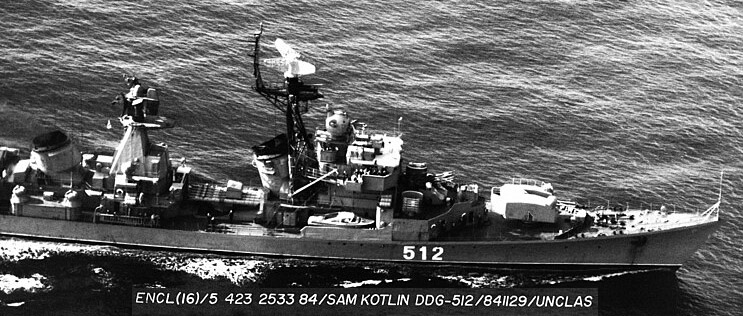
“FAIR” was from Leningrad, Zhdanov, comp. December 20, 1956, comm. December 27, 1956. 128 Brigade, 1957 artillery exercises, 1958, ASW training, 1959, fleet tactics. 1961 exercises. October 1962 visit to Rostock, East Germany. May 1964 visit to Copenhagen with “Svetly”. October 1964 escorted the cruiser “Sverdlov”, 4 submarines, 2 tankers in the North and Norwegian Seas, monitoring NATO exercises “Folence-64”. May 1966 to November 1969 OVL at Zhdanov, project 56A missile ship. 1970 exported, officially recommissioned on June 25, 1970 in the Polish Navy in Gdynia and renamed “Warsaw”. January 27, 1971 decommissioned from the Soviet Navy. Warsawa was stricken in 1986.
 Nesokrushimy
Nesokrushimy

“INBREAKABLE” was from Leningrad, Zhdanov, comp. June 30, 1957, comm. September 13, 1957, Northern Fleet, 170th brigade, Severomorsk from September 1957. December 1960 OVL in Kronstadt (cap. 2nd rank E.P. Sokolov). April 1962 Severomorsk, 1963 artillery exercises. May 1964 Black Sea Fleet. January 1965 OVL. February 1968 Northern Fleet, 170 Brigade, 7 opesk. October 1969 to December 31, 1970 OVL at 61 Kommunar, Nikolaev, modernized Project 56A. February 1973 to April 1979 placed i restricted availability. 56 Brigade, 7 opesk. Unauthorized launch of a combat missile at the Severomorsk pier. July 1980 to January 1982 restricted av. August 1983, 206 brigade. March-April 1984 took part in “Atlantik-84” exercises. February 1987 placed in reserve, April 1988, target SM-251. Survived. Decommissioned on July 27, 1991, stricken, BU.
 Nakhodchivy
Nakhodchivy
Built in Leningrad, Zhdanov, comp. September 26, 1957, comm. November 15, 1957. Acceptance tests in Kronstadt and November 1957, Severomorsk, Northern Fleet. August 1959, ASW exercises. December 1960, fixes at Kronstadt. Assigned April 1962 170 Brigade. July-August and september 1964, exercises, Norwegian Sea with cruiser Moskovsky Komsomolets. June-July search for US SSNs as part of the “Pechora” exercises and August-October 1965 Mediterranean exercizes, transfer to the Black Sea Fleet. Converted at 61 Kommunar Yard as Project 56A, comp. December 25, 1965, left November 1966 and January-June 1967, August-December 1968 military presence in Egypt, monitoring US presence. March 1969, 30th Brigade. August 1969 visited Varna, Bulgaria and April 1970 Okean maneuvers. August 1973 visit to Constanta with cruiser Admiral Golovko and Krasnodarsky Komsomolets under Vice Adm. B.E. Yamkovogo. 1973, fire in SAM storage. April 1974 visit to Algeria (RADM V.I. Akimov) with Sverdlov and a submarine. 1975 Atlantic Ocean, Mediterranean, August 1975 visit to Tunisia, Algeria, Yugoslavia, Bulgaria. August-September 1976 escorted Kyiv transiting from the Black Sea Fleet to the Northern Fleet, stopping at Burgas, Volgarad. November 1976 ex. Mediterranean Sea (under capy. A. Rumyantsev). March 1984, while entering Dardanelles, she was grounded. Repaired in Sevastopol. 1987 visited Split. February 9, 1988 reserve, April 1989 decommissioned, October 1989 stricken. 1990 towed for scrapping to Italy, Porto Norara.
 Nastoychivy
Nastoychivy
“PERSISTENT” was from Leningrad, Zhdanov, comp. November 30, 1957, comm. April 19, 1958, Northern Fleet, 170th brigade at Severomorsk April 1958. June 1958, visited by CiC of the Navy. October 1958, ASW exercise, Northern Fleet. September 1959 awared 1st place. July 1960, excellence award. November 1960 2nd place ASW/arty. September 1961 to March, OVL Rosta. July 1964 Norwegian Sea; October 1964 visit Trondheim, Stockholm escorting the cruiser “Murmansk” (VADM CM. Lobova). July 1965, tracking USS icebreaker off Novaya Zemlya. April-May, June-August 1966 North Atlantic tracking US Fleet and searching for US SSBNs. May 1967 left for the Black Sea Fleet, stopp at La Valletta (Malta), June 5, 1967, arrived in Sevastopol. Conversion at 61 Kommunar Yard as Project 56A, sea trials on December 1969. March 1970 resumed combat service, Mediterranean, visited Split, Alexandria. August 1970, transferred to the Baltic Fleet, 12 brigade. March-October 1971 Mediterranean with escorted cruiser “October Revolution” with Speshny. November watched Indo-Pakistani war. Bay of Biscay and by August visit to Helsinki and North Atlantic ex.. April-July 1973 North Atlantic, August 1973 stopped at Constanta, November 1973 visited by Navy CiC. March-April 1974 West Atlantic, stopped at Conakry (Guinea). June 1974 North Atlantic escorting cruiser Sverdlov, July visited Cherbourg, France. October 1974 awared 1st place in artillery preparations. March 1975-May 1976 OVL at SRZ-29. Transferred 76th brigade. August 1976 Copenhagen, September West Atlantic and stopp ed at Conakry. December 1977 to January 1978 military presence in Angola, stopped in Luanda, Conakry, Cotonou (Benin). February 1978 visited by CiC. June 1978 visited Amsterdam, September CiC prize for artillery preparation. June 1979 visited Helsinki. December 1979 OVL SRZ-29. August-September 1983 joint exercise with East Germany and Poland “OBESK-83”, stopped at Gdynia. October 1984, new prize for artillery preparation. October 1987 OKOP exercise. April 25, 1989 decommissioned, October 1, 1989 stricken in Liepaja. March 1990 BU in Italy.
 Byvalvy
Byvalvy
“ELUSIVE” was Built in Leningrad, Zhdanov Yard, comp. December 30, 1958, comm. March 8, 1960. Baltic Fleet, 12th brigade under Yu.A. Gusev. 1961, during missile firing target training ship Komsomolets was sunk. 1962 and 1963 artillery exercises. 1964, long-range target designation ex.. 1964 missile exercises. Reclassed as large rocket ship. 1967 exercises, 1968, tactical fleet ex. 1969 Western Atlantic, February visit Conakry, March 1969 Lagos, Nigeria with Boyky, submarine and tanker. April 1969 transferred Black Sea Fleet, 30th brigade. February 1970, escorted K-8 submarine through Gibraltar. April, Okean maneuvers, December 1970, restricted av. December 1971 to October 1972 OVL in Zhdanov, Project 56U. January 1973 reclassied as destroyer. 1973, Mediterranean Sea. June 6 1976 to March 18, 1982 reserved in Sevastopol, 63rd brigade Troitskaya Balka. May 1985, missile test was rated “excellent”. April 19, 1990 decommissioned, February 11, 1991 stricken, BU in Sevastopol.
 Bravy
Bravy
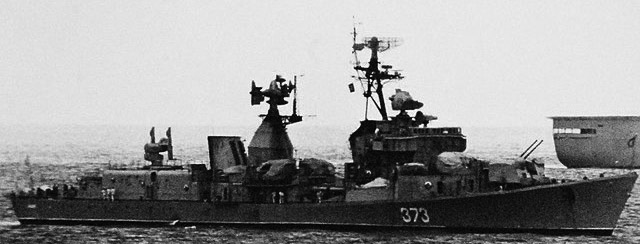
“BRAVE” was from Nikolaev, plant named after. 61 Communara. Project 56 – 56K.
closed – September 3, 1952, hall – July 25, 1953, joint – February 28, 1955, reception – January 9, 1956, rise – January 28, 1956.
As part of the Black Sea Fleet (30 dplk). From May 27 to August 23, 1960 it was modernized at plant No. 445 on Project 56K, from January 3 to April 30, 1962 it tested the M-1 air defense system (46 launches, 6 targets shot down). In June 1962 he arrived in Severomorsk, took part in the parade and exercises of the Northern Fleet “Kasatka”, and on July 21 hit an air target. Since March 31, 1969 in the Black Sea Fleet, consisting of 30 dnk (150 brrk). In April 1970, participation in the Ocean maneuvers. November 9, 1970 collision with the aircraft carrier “Ark Royal”, damage to the stern and propeller shaft but 2 people died (cap. 2nd rank JI.P. Balash). Repair in Sevastopol, transferred to 70 brplk from December 30, 1970. In 1972 exercises. In 1973, military service in the Mediterranean Sea, escorting transports from the Dardanelles to Latakia (Syria). In 1975, repairs and modernization of the air defense system. In July 1976, he entered military service in the Western Atlantic, August 24-28, visit to Guinea (Bissau), November 9-12, 1976 to Luanda (Angola), November 22-27, 1976 to Lagos (Nigeria). Combat service in the Mediterranean, August 5-9, 1977 visit to Constanta (Romania). March 2, 1979 for repairs in Sevastopol, then mothballed as part of the 63rd brigade, July 30, 1987 decommissioned. stricken on August 6, 1987. Cut in Sevastopol.
 Bessledny
Bessledny

Besslednyy colliding with USN destroyer USS Walker, sea of Japan, 10 May 1967
She built at was Nikolaev, 61 Communar, commissioned December 21, 1955, comp. January 4, 1956. Black Sea Fleet (30 dplk). October 1957 she escorted the cruiser “Kuibyshev” for a visit to Zadar and Dubrovnik in Yugoslavia under cap. 3rd rank V.H. Sahakyan. From May 1959 she was reassigned to the Northern Fleet, 120th dplk. From March 1960 restricted av. July 1961 rescue of the crew of the damaged submarine K-19. November 1961 Baltic Fleet, June 1962 to October 1965 modernized in Tallinn, Project 56-PLO. April-May 1966 sailed with “Nastoichivy” to the Norwegian Sea, Northeast Atlantic, to shadown NATO TG. Januar 1968, 7th Special Forces Squadron, Northern Fleet 170 dplk. From August 1969 to January 1971, OVL. August 1971 visited Algeria and March-May 6, Guinea. October 1972 search operations in the Norwegian Sea North Atlantic, exercises “Duet” and “Laguna”, destruction of sonar buoys with depth charges, “Elbrus” ASW fleet exercise. November 1972, off Conakry (Guinea) and January 1973 intercepted ships. April 1973 OVL Severomorsk. June 1974 Mediterranean Sea, Casablanca, took part in movie “Commander of the Happy Pike”. In 1974 fire at the dock in Sevastopol. 1975 ASW exercises. November 1977 to October 1978 OVL, transferred to 56 brigade. 1979 North Atlantic. July 1982 OVL Severomorsk. March 1983 training minelaying. April fleet exercise. August 1983, 206 Brigade. July 1988 decom. October 1988 stricken, sold for BU.
 Burlivy
Burlivy
Built at Nikolaev, 61 Communar, comp. December 28, 1956, comm. January 7, 1957. Until August 1957 transition to the Pacific Fleet, via the Suez Canal (cap. 3rd rank I. Soldatov). From December 12, 1961 to March 25, 1963, modernization at Dalzavod (79 brstremk) as Project 56PLO. September 1966 included in the 201st Brigade. January-March 1968 Korea Strait, April 1968 tracking USS Ranger TG, rescuing Korean fishermen to Busan, KTOF prize for artillery training. October–November 1969 Operation “Wave” in the Philippine Sea. April–May 1970 Sea of Japan, “Okean” maneuvers, November 1970 10th brigade. September-October 1971, exercise “Voskhod” (preemptive strike against a USN task force) awared first place in anti-submarine training and of the Navy Civil Code. March 1972, 10th Brigade. From February 1973 in reserve. November 20, 1974, transferred to mothballs, Novik Bay. October-December 1980 dry-docked. April 25, 1989, decommissioned. stricken on October 1, 1989. 1993, scrapped in China.
 Bedovyy
Bedovyy
Built at Nikolaev, 61 Communar, comp. June 30, 1958, comm. July 30, 1958. Black Sea Fleet, DesRon 30, first equipped with anti-ship missile system. February 1957, first launch of a KSShch missile at Cape Chauda. Fired a missile at the interwar DD leader “Yerevan”. October 1958 on a Project 82 target ship. 1958 cap. 2nd rank V.H. Sahakyan took command, she was reclassified as a destroyer. December 8, 1958, sank a decommissioned minesweeper for testings. December 14, 1958 same on TSCH-188. 1960 artillery and missile exercises and 1961 tactical exercises. 1962, artillery and rocket firing. 1964 exercises. OVL from 1965. November 7, 1965 parade in Sevastopol. May 1966 reclassified DBK. March 1969, reassigned to DesRon 30. July 1969, visited Havana with the cruiser “Grozny”, and Martinique. August 1969, visited Bridgetown, Barbados, Gibraltar and back to Sevastopol. June 1970, DesRon 11. October 1970 to July 1971, military presence in Egypt, visited Alexandria. From July 18, 1972 OVL at Sevastopol until January 1974 in Nikolaev as project 56U, DesRon 70. August 1974 exercises, rescue and towing of the Bravyy. 1976 exercises. 1978, same and from April 23, 1981 to May 14, 1986, OVL Sevastopol. Decom. 1989, stricken October 1, 1989 stricken. BU in Inkerman.
 Blagorodny
Blagorodny
Built at Nikolaev, 61 Communar, comp. September 30, 1955, comm. October 8, 1955. Black Sea Fleet, DesRon 30 dplk. October 1957 escort a cruiser carrying the Ministry of Defense G.K. Zhukov to Zadar and Dubrovnik in Yugoslavia under K-adm. A.N. Tyunyaeva. From February 6, 1958 to March 10, 1960, modernized at Sevastopol Morzavod, Project 56-PLO. Went to the Suez Canal, Port Said and by October 20, 1960 transferred to the Pacific Fleet, DesRon 173, Kamchatka flotilla. November 15, 1967, DesRon 201. 1968: exercises. November 15, 1969 departed for the Indian Ocean. November 26 – December 1 visited Sihanoukville, Cambodia. January 1970 visited Hodeidah, S. Yemen and February Massawa in Ethiopia, Port Louis in Mauritius and from May, Okean exercises. Back in Vladi by June 3, 1970. November 22 saw her reassigned to DesRon 175. From January 6, 1971, Indian Ocean (stopped at Massawa, Ethiopia), traveled 25,000 miles. October-November, ASW exercises, awared prize for finding nuclear submarines. From March 15, 1972 included, desron 193. October-November 1972 exercises, awarded second prize for searching SSN, and artillery. 1973, Indian Ocean. From December 25, 1974 to September 6, 1978, OVL at Dalzavod. Decom. July 30, 1987, stricken August 6, 1987. Ship cemetery of Truda Bay.
 Blestyashchy
Blestyashchy
Built at Nikolaev, 61 Communar, comp. August 31, 1956, com. November 6, 1956. June-August 3, 1957, inter-naval transition to the Pacific Fleet via the Suez Canal, Port Said under cap. V. Mamchintsev. 1966, DesRon 173, Kamchatka flotilla. April 1970 Okean maneuvers, forced entry into a foreign port to disembark a patient. February 3 to July 9, 1971, Indian Ocean. May 25, 1973 to May 8, 1976, modernization at Dalzavod, Project 56-PLO. 1976, Sea of Japan. May 1977 mothballed, April 1979, listed with DesRon 175. July 17, 1988 decommissioned, stricken October. Sold 1989 for BU but sank in January 1990 while under towed in the South China Sea, close to Taiwan.
 Plamenny
Plamenny
Built at Nikolaev 61 Communar, Black sea fleet, comp. August 31, 1957, comm. September 21, 1957, assigned DesRon 30. 1958, 1959, 1960 exercises and tests. January 18, 1961 to June 4, 1962 converted as Sevastopol as Project 56-PLO. 1963 exercises. August 1964 visited Constanta, Romania with the cruiser “Dzerzhinsky” (adm. G.K. Chernobaya). July 1965, fire support training for landing with the cruiser Mikhail Kutuzov. January 1966 left Sevastopol for the Ethiopian Navy Day, Massawa. June 1967, August to December 1968 military presence in Egypt, stopped at Port Said and Alexandria. Late 1968 was awared prizes for mine and ASW training, artillery, of the Black Sea Fleet. March 31, 1969, DesRon 21. April 1970 Okean maneuvers. June 1970, assigned DesRon 11. January-May 1971, Mediterranean Sea service. October 1973 military presence in Syria. July 30 1975 to July 31, 1979: Major OVL at Sevmorzavod, reserve. Decom. June 24, 1991 at Donuzlav, strocken October 1, 1991. Abandoned in Inkerman, half-flooded.
 Naporysty
Naporysty
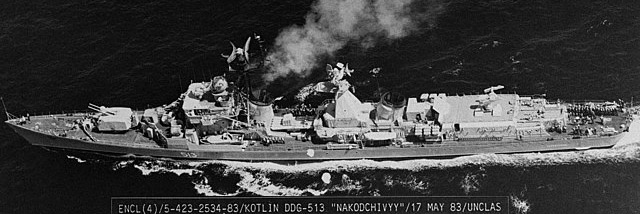
Built at Nikolaev 61 Communar, black sea fleet, comp. July 18, 1956, comm. June 30, 1957, DesRon 11, 30th Brigade under 2nd rank A.P. Isaev. August 1959, Mediterranean TOD, stopped in Vlora, Albania under CiC S.G. Gorshkova. Missioned was to advise on construction of secret naval bases long the Albanian coast. May 20 – June 12, 1960, evacuation of advisors from Vlora, Albania. 1962, exercises. 1963, modernization, project 5611LO. 1966 exercises. June 1967 Mediterranean service, escorting SSGNs through Gibraltar. June 1967 military presence in Syria, stopped at Tartus. Hosted the Mediterranean squadron (5th division) HQ. March 1969, assigned to DesRon 30. April 1970, Okean maneuvers. May 1971 Mediterranean service and by October visited Latakia, Syria. From August 13, 1973 to October 7, 1976, OVL at Sevastopol. November 1976, Mediterranean service. 1978 Western Atlantic, stoping at Conakry (Guinea), Cotonou (Benin), Luanda (Angola), protecting shipping and providing communications for Tu-95 aircraft. March 21, 1980 Mediterranean Sea. June-July visit to Tunisia, Split and back. September 15, 1982, Leningrad Military Base. 1988, placed in reserve, docked, machines overhauled, trials, still capable of 38.5 knots. April 1989 decom., stricken December 31, 1989, sold for BU 1992 in Portugal.
 Vyzyvayushchy
Vyzyvayushchy
Built at Nikolaev, 61 Communar, comp. October 31, 1957, comm. November 22, 1957. Black Sea Fleet, DesRon 30 and 1958 exercises. 1959 same as 1960. February 8, 1961 to August 19, 1962 converted at Sevastopol Marine Plant as Project 56-PLO (capt. P.R. Dubyaga). August 1964 visited Varna, Bulgaria with Mikhail Kutuzov (Adm. V.F. Chaly). 1964, artillery firing exercises. February 1965 visited Maccava, Ethiopia. September 1966 Mediterranean TOD with Zorkiy and 3 submarines, 11 auxiliary ships. October, first official visit to Toulon, France and back home December 1966. August 1967, visited Varna with Grozny, Soobrazitelny and 2 submarines. January-November 1968, stayed off Egypt, visited Alexandria. From March 31, 1969 assigned to DesRon 30 and by April 1970 Okean maneuvers. 1971: Repairs and modernization. August 1973, Mediterranean TOD. October-December military presence off Syria and Egypt, evacuation of personal from Alexandria. From February 10, 1977 to September 15, 1979 in reserve, Donuzlav. 1980 exercises. 1982 same. Decomm. July 30, 1987, stricken October 1, 1987, sold for scrap, Inkerman.
 Vesky
Vesky
Vesky was built at Komsomolsk-on-Amur, completed March 30, 1956, comm. April 13, 1956. Assigned to the Pacific Fleet, DesRon 175 and by April- 1958 to February 28, 1959 overhauled at Dalzavod, and by September-October 1959 trained off Japan. By October 1961 under capt. lieutenant V. Zaitsev she rescued 9 pilots from a downed Be-6 aircraft. 1963: exercises. From January 24, 1964 to February 1, 1965, OVL at Dalzavod. April 25–June 26 1965, Philippine Sea (8250 miles). 1966, joined the 9th division. April 1966, 45-day trip to Guam, awared prize at the Pacific Fleet. April-May 1967 Philippine Sea, prize of the Navy Civil Code. May 8, 1967 shadowed USS Hornet TG. May 10 while chased off by USS Waller she collided with her. Needed repairs afterwards. October 1967, Philippine Sea shadowed the US submarine base. November won the Navy Civil Code prize again for tactical/artillery training, 2nd Pacific Fleet prize. February 1968 saw her in the Sea of Japan and North Korea, coast. From July 1968, OVL Dalzavod. February 1969, Sea of Japan. August 30, 1969 to July 16, 1970, OVL Dalzavod. August 1970 assigned to DesRon 201. December 22, 1970, DesRon 175. March-April 1971 shadowed US ships in the Sea of Japan. June 19, 1971 – January 17, 1972, exercizes, Indian Ocean, shadowed USS Enterprise TG, making 32,120 miles and stopping to Berbera, Aden. From March 15, 1972, integrated DesRon 193, 10th Brigade, and by May-June 1972 was in the Gulf of Tonkin. October 12, 1976, rescued the crew of the tanker “Tavrichanka” which sank in the Chinese Sea. December 6, 1977 to July 21 1978 she stayed off Ethiopia. From August 17, 1978, modernization. From April 1979, DesRon 193, 10th brigade. 1979: exercises. 1980, modernization at Dalzavod. July 30, 1987, decommissioned, stricken October 1, 1988, left half-flooded in Truda Bay.
 Vdokhnovenny
Vdokhnovenny
Built at Nikolaev, 61 Communar, she was completed on December 30, 1958, commissioned March 8, 1960 as Project 56A (missile conversion), assigned to the Black Sea Fleet, DesRon 30, performing her first missile launch on October 31, 1958 at a decommissioned minesweeper. In June 1961 she tested further the KSShch missile system at an decom. Project 7U destroyer and the cruiser Admiral Nakhimov. From May 19, 1966 she was reclassified “large missile ship” (LRK) and was in 1968 exercises. From March 1969 she joined 30 dplk and by April 1970 was in Okean maneuvers. In 1972 in exercizes and by November 24, 1973, she was modernized in Nikolaev, 61st Communard as a Project 56U. On February 1, 1977 reclassified as BPK. In December 1977-January 1978 she served off West Africa, stopping at Conakry, Guinea. On August 25, 1978 she was reassigned to the Baltic Fleet, 76th Brigade, 12th. By June 1979 she visited Helsinki and by late 1979 was off in Angola. By September 1982, she shadowed USS America and the assault carrier USS Guadalcanal in the North Sea during NATO “Northern Wedding-82” (250 ships). Decomm. June 24, 1991, stricken October 1, 1991 sunk at berth (accidental) by October 1992, raised and BU 1994.
 Vozmuscheny
Vozmuscheny
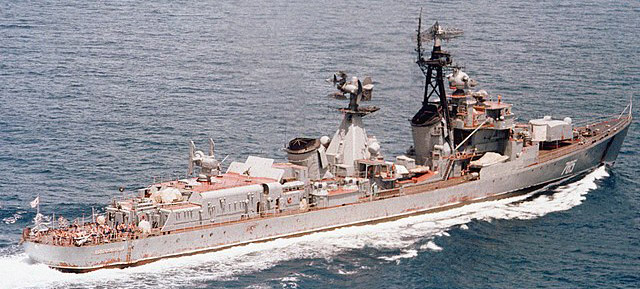
“CALLER” was built at Komsomolsk-on-Amur, completed September 4, 1956, commissioned April 20, 1956, assigned to the Pacific Fleet, DesRon 175. From November 24, 1961 to January 30, 1965 she was overhauled and converted to a Project 56-PLO destroyer at Dalzavod. From June 1965, she trained near the Hawaiian Islands after 8,250 miles. By August 1966 she joined DesRon 201, 9 Brigade and won the Pacific Fleet prize for markmanship at coastal targets under cap. 2nd rank A.P. Mamonchikov. In 1966 she helped assisting extinguishing a fire on submarine K-66. In September 1966 she escorted in the strait of Ugaru sub missile exercizes, and stopped at Chongjin, NK. From May 17 to July 2, August to September 1967, she trained in the Philippine Sea. From February and May-June 17 1968 in the Sea of Japan and off North Korea. From May to June 1969 she returned to the Sea of Japan. In March 1970-March 1972 she was overhauled at Dalzavod. From March 1972 she was assigned DesRon 10, From May to November 1972 served in the Indian Ocean (27,320 mile, Berbera, Colombo, Port Louis). In 1974-75 she trained in realistic anti-aircraft defense/air defense tactics. In 1976 she was in exercises like in 1978. She was decommissioned on April 25, 1989, stricken October 1, 1989, sold for BU in 1994.
 Vozbuzhdeny
Vozbuzhdeny
“INSPIRED” was built at Komsomolsk-on-Amur, completed October 31, 1956, commissioned November 12, 1956. Assigned to the Pacific Fleet, DesRon 175 and by September-October 1958 she took part in artillery exercises. From January 1960 to March 1961she was modernized at Dalzavod, Project 56-PLO. From September 30, 1962 she was in restricted availability in Novik Bay, and by 1965 transferred to Strelok. In December 1965 she received a the Kola station and from August 31, 1966, joined DesRon 9. In 1967, she trained in the Sea of Japan and Korean Strait. On October 22, 1968 she sailed in formation with “Admiral Fokin”, “Gnevny”, “Danube”, “Ulma” in the Indian Ocean and on December 2, 1968 visited Mombasa then on, January 2-7, 1969 Aden and by January 9-12, 1969 Hodeidah then Bombay and back to Vladivostok on April 4, 1969 after 25,600 miles travelled under command of capt. 2nd rank V. Marin.
On April 15-16, 1969 she rescued the crew of a shot down AWACS plane in the Sea of Japan. By December 22, 1970 she was reassigned to DesRon 175th (201st brigade). On October 1971 she shadowned USS Midway in the Sea of Japan. From March 15, 1972 she joined DesRon 193 and by January until March 1975 she was in ovehauled. By October 1976 she was in the Indian Ocean as in 1978 and 1979, stopping at Beira, Aden, Massawa, Cam Ranh. From April 24, 1979 she joined DesRon 175. Placed in reserve in 1986, she was decommissioned on July 30, 1987, stricken October 1, 1987, towed in 1988 and abandoned half-submerged, rotting since.
 Vliyatelny
Vliyatelny
“OUTRAGED” was bilt at Komsomolsk-on-Amur, completed on December 31, 1956, commissioned on January 10, 1957. Pacific Fleet, she made her first missioned with the special forces, then DesRon 173, Kamchatka flotilla. In 1959, she was assigned to the protection of fisheries in the Sea of Okhotsk. From October 20, 1961 she was assigned to DesRon 201. On February 15, 1961 she was decom. at Dalzavod for modernization, Project 56-PLO. From July 18, 1962 she made her sea trials, and from September 30, 1962, mothballed for fixes. By order of the USSR Ministry of Defense on July 30, 1987, she was decommissioned and she lays since 1989 in Truda Bay, Russky Island, semi-flooded and rotting.
 Vyderzhanny
Vyderzhanny
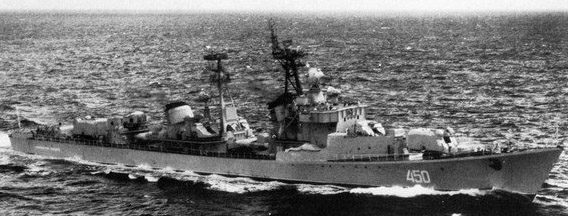
“EXCITING” was built at Komsomolsk-on-Amur, completed on October 31, 1957, commissioned on November 14, 1957. Assigned to the Pacific Fleet, DesRon 175 under Capt. Lieutenant. Volobuev. By November 17-21, 1959 she sailed with the cruiser “Admiral Senyavin” (Vice Adm. V.A. Fokina) to Jakarta. Awarded the “best ship of the Pacific Fleet” in 1959. From August 24, 1965 to July 16, 1969 modernized as Project 56A in Dalzavod. From December 26, 1969, assigned DesRon 175 and by April 1970, took part in the Okean maneuvers over 3,825 miles. From July 17, 1970 to February 8, 1971 she cruised in the Indian Ocean (23,140 miles, stopping at Berbera, Aden). From June 16, 1971 she was assigned to DesRon 173, Kamchatka flotilla and departed in November for the Indian Ocean with Strogiy under Rear Adm. B.C. Kruglyakov. She visited Umm Qasr in Iraq and Port Louis, Mauritius. From October 7, 1975 to March 2, 1978, she had an overhaul at Dalzavod. Later she returned to the Indian Ocean in 1979 with the cruiser “Admiral Fokin” and stopped at Haiphon. In 1981 she was again in the Indian Ocean and by Mayn visited Aden. From March 8, 1982 she was placed in reserve. Decommissioned on April 25, 1989, stricken October 1, 1989, subk as target 1990 off the coast of Kamchatka.



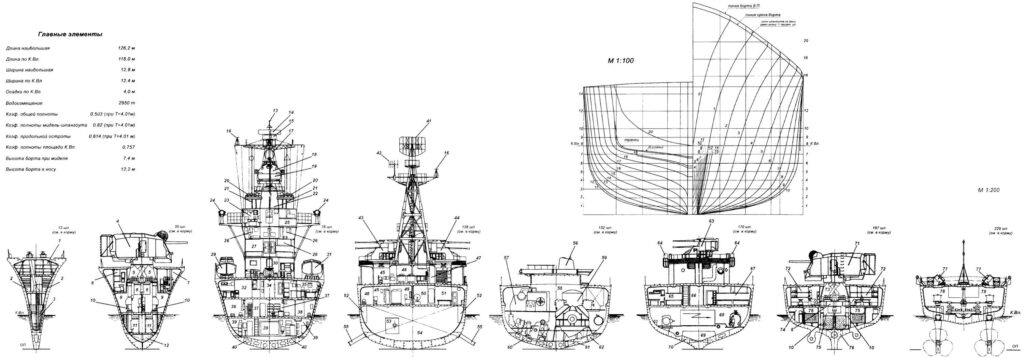

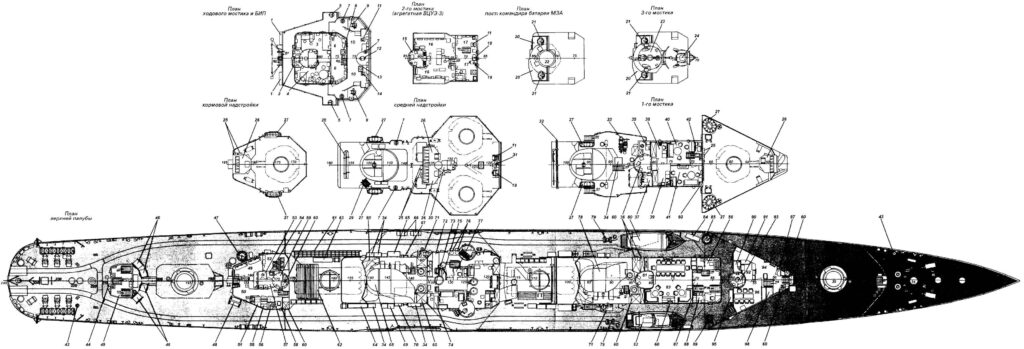

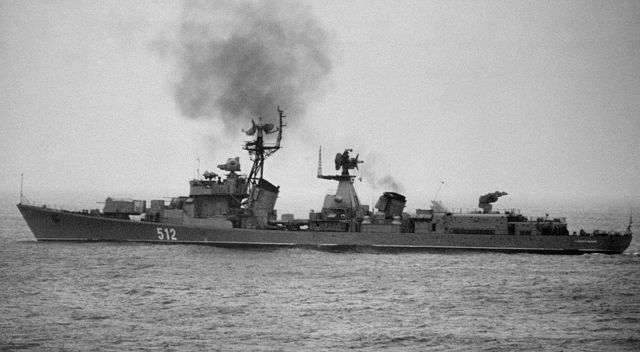

 Latest Facebook Entry -
Latest Facebook Entry -  X(Tweeter) Naval Encyclopedia's deck archive
X(Tweeter) Naval Encyclopedia's deck archive Instagram (@navalencyc)
Instagram (@navalencyc)





 French Navy
French Navy Royal Navy
Royal Navy Russian Navy
Russian Navy Armada Espanola
Armada Espanola Austrian Navy
Austrian Navy K.u.K. Kriegsmarine
K.u.K. Kriegsmarine Dansk Marine
Dansk Marine Nautiko Hellenon
Nautiko Hellenon Koninklije Marine 1870
Koninklije Marine 1870 Marinha do Brasil
Marinha do Brasil Osmanlı Donanması
Osmanlı Donanması Marina Do Peru
Marina Do Peru Marinha do Portugal
Marinha do Portugal Regia Marina 1870
Regia Marina 1870 Nihhon Kaigun 1870
Nihhon Kaigun 1870 Preußische Marine 1870
Preußische Marine 1870 Russkiy Flot 1870
Russkiy Flot 1870 Svenska marinen
Svenska marinen Søværnet
Søværnet Union Navy
Union Navy Confederate Navy
Confederate Navy Armada de Argentina
Armada de Argentina Imperial Chinese Navy
Imperial Chinese Navy Marinha do Portugal
Marinha do Portugal Mexico
Mexico Kaiserliche Marine
Kaiserliche Marine 1898 US Navy
1898 US Navy Sovietskiy Flot
Sovietskiy Flot Royal Canadian Navy
Royal Canadian Navy Royal Australian Navy
Royal Australian Navy RNZN Fleet
RNZN Fleet Chinese Navy 1937
Chinese Navy 1937 Kriegsmarine
Kriegsmarine Chilean Navy
Chilean Navy Danish Navy
Danish Navy Finnish Navy
Finnish Navy Hellenic Navy
Hellenic Navy Polish Navy
Polish Navy Romanian Navy
Romanian Navy Turkish Navy
Turkish Navy Royal Yugoslav Navy
Royal Yugoslav Navy Royal Thai Navy
Royal Thai Navy Minor Navies
Minor Navies Albania
Albania Austria
Austria Belgium
Belgium Columbia
Columbia Costa Rica
Costa Rica Cuba
Cuba Czechoslovakia
Czechoslovakia Dominican Republic
Dominican Republic Haiti
Haiti Hungary
Hungary Honduras
Honduras Estonia
Estonia Iceland
Iceland Eire
Eire Equador
Equador Iran
Iran Iraq
Iraq Latvia
Latvia Liberia
Liberia Lithuania
Lithuania Mandchukuo
Mandchukuo Morocco
Morocco Nicaragua
Nicaragua Persia
Persia San Salvador
San Salvador Sarawak
Sarawak Uruguay
Uruguay Venezuela
Venezuela Zanzibar
Zanzibar Warsaw Pact Navies
Warsaw Pact Navies Bulgaria
Bulgaria Hungary
Hungary

 Bundesmarine
Bundesmarine Dutch Navy
Dutch Navy Hellenic Navy
Hellenic Navy Marina Militare
Marina Militare Yugoslav Navy
Yugoslav Navy Chinese Navy
Chinese Navy Indian Navy
Indian Navy Indonesian Navy
Indonesian Navy JMSDF
JMSDF North Korean Navy
North Korean Navy Pakistani Navy
Pakistani Navy Philippines Navy
Philippines Navy ROKN
ROKN Rep. of Singapore Navy
Rep. of Singapore Navy Taiwanese Navy
Taiwanese Navy IDF Navy
IDF Navy Saudi Navy
Saudi Navy Royal New Zealand Navy
Royal New Zealand Navy Egyptian Navy
Egyptian Navy South African Navy
South African Navy






























 Ukrainian Navy
Ukrainian Navy dbodesign
dbodesign